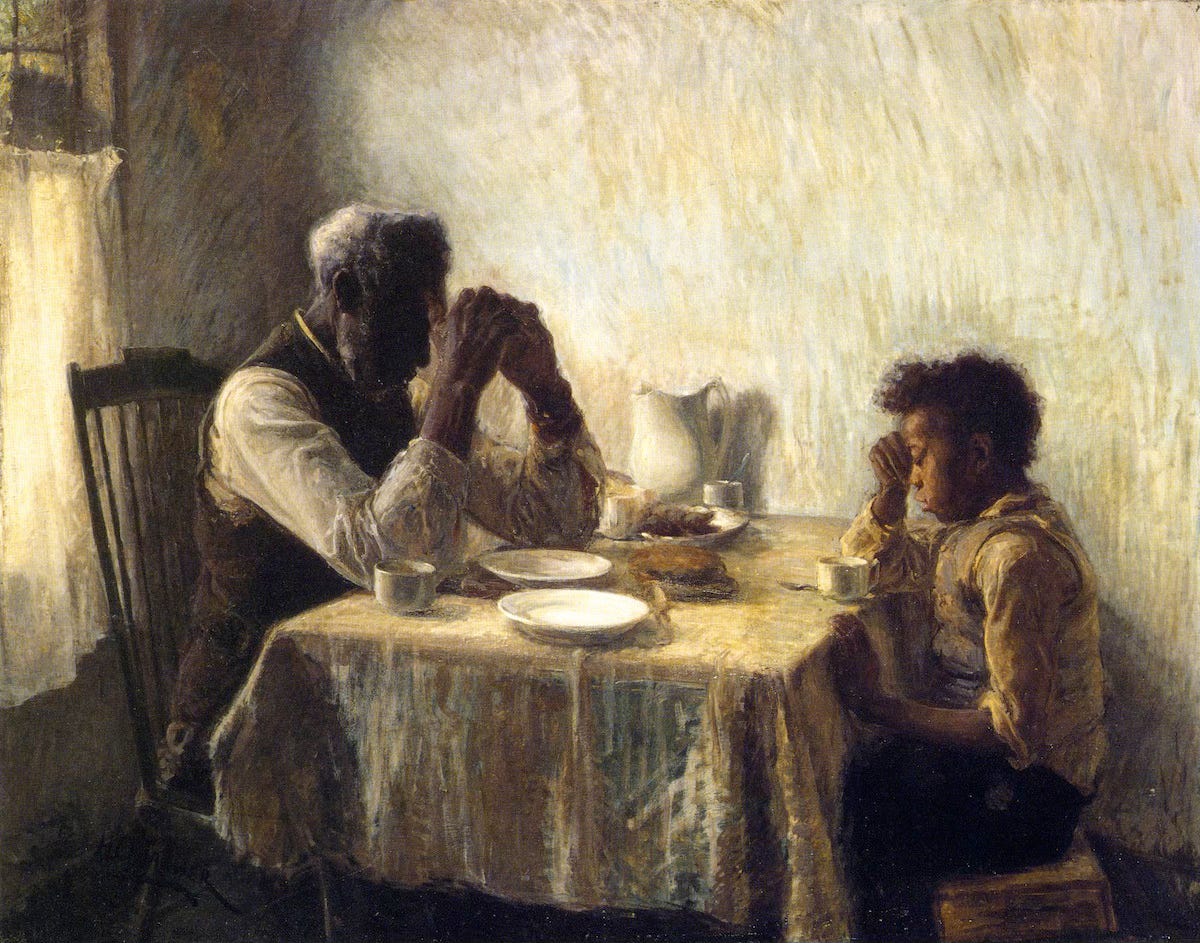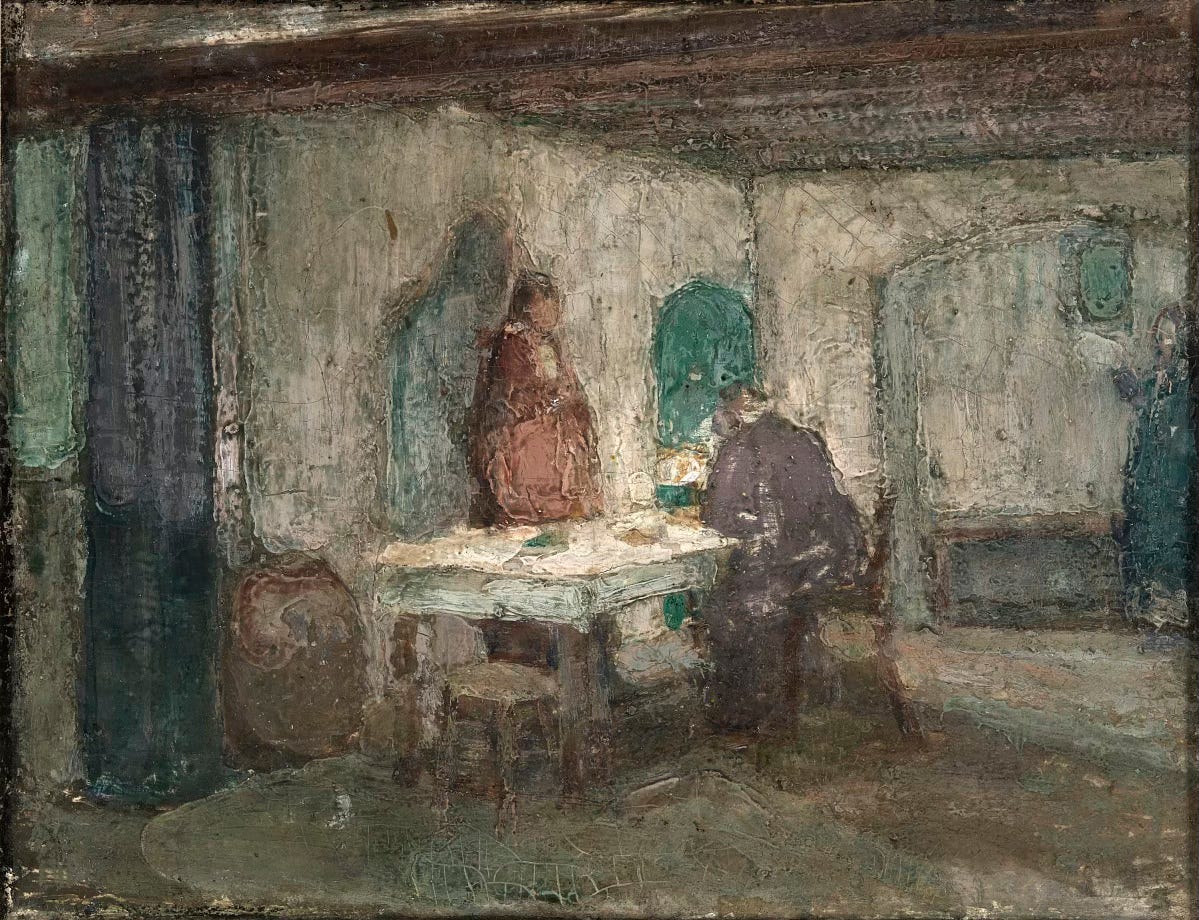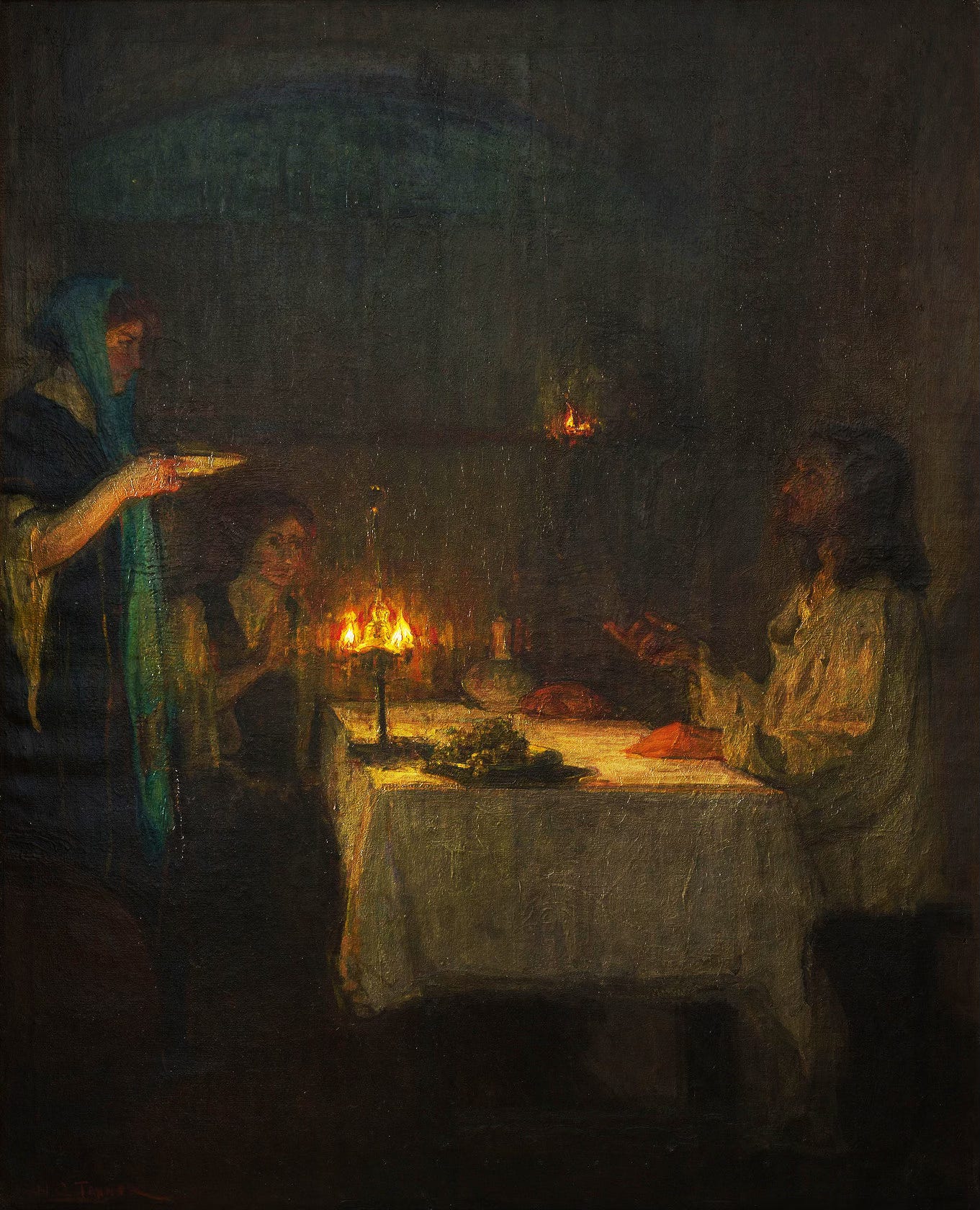A Liturgy of Tables
The terrible thing is that beauty is not only fearful but also mysterious. Here the devil is struggling with God, and the battlefield is the human heart.—The Brothers Karamazov, Fyodor Dostoevsky
A sporadic melody pierced the quiet stillness of what was until then a cool mid-summer Sunday morning. Reveille. Almost instantly, drill instructors rushed to the scene, and our five-minute countdown to formation began. Amid all this, I groggily got up after night watch and an uncomfortable four hours of sleep. I hurriedly folded a worn, coarse blanket over my cot and joined the rest of my squadron in quickly opening the flaps of our Vietnam-era field tent. Thanks to the holes scattered across the faded army green material, we had nicknamed our tent “Starry Nights,” admiring the nightly view through our makeshift roof, only to have our endearment quickly fade when we realized the tent was no match for Colorado’s summer storms. My tiny group of eight aspiring Air Force Academy cadets all begrudgingly laughed when we saw our uniforms for the day had been soaked the night before.
Lined up in our damp OCPs, we briskly marched to a quick and hearty breakfast of what we called SOS: government-quality biscuits and gravy. We tried to contain our giddiness as we gathered around a pop-up plastic table for an ominously silent ten-minute meal; we were anticipating a break from the hardships of the week as we would soon be released for church.
The beckoning hum of “Come, Come Ye Saints” guided our arrival to a makeshift chapel. We were warmly met with hugs and the characteristic buzzing chatter of cadets eager to socialize and catch up. Sitting on aluminum bleachers warmed by the summer sun, bald heads glimmering, we watched as the sacrament was blessed on another foldable table. After the service, we quickly devoured cookies that had been snuck in by a senior couple and placed on the provisional altar, then we hurried back to our impatient drill instructors.
Soon after, we formed up again and found ourselves double-timing to a place affectionately called “Hell’s Half Acre.” As we arrived, each unit was ordered to crawl on the ground. Soon, our wet uniforms became coarse and stiff with heavy red dirt. Breathing deeply left me inhaling more of my sweaty mask than the sweet, thin air I desperately needed, while dirt coated my mouth, and my heart pounded amidst the chaos of gunfire, yelling, and explosions—a visceral experience I will never forget.
These were the moments I dreamed of as a little boy growing up in an army family. In anticipation of my future career in the military, I would often sneak into my grandpa’s back closet and slip into his old uniform; paired with the wooden rifle grandpa had carved for me, with his shaky, war-weathered hands, it was all I needed out on his half-acre lot to totally lose myself to imagination. It was only Mom who could steal me away from these backyard wars; armistice would quickly ensue as I rushed away from my troops to be first at the table, the first to tuck into the catalyst for peace: Mom’s cooking.
Looking back, taking my seat at our family’s table was an early lesson in holiness. It was a rupture in ordinary time, a sacred revelation of my place amidst my family, my community, and the world. To be around the table brought fully to bear the novelties of existence as an embodied being: hearing laughter and sobs, tasting new foods, smelling the savors of home and season, seeing those who proclaimed love for me and each other and subsequently embracing them. Such gathering was—and remains—a liturgical act, a worshipful participation in the outreaching love of God by which we are rendered fully alive.
What began in the intimacy of my family’s table widened in scope during my mission in Northern France and Belgium, where the table became a place not only of nurture and belonging but also of conflict, displacement, and fragile hope. Almost immediately after Russia’s initial invasion of Ukraine, refugee camps were set up all around Belgium. We once shared a table with a man whose apartment had been bombed on the first day of the invasion. He had watched his daughter and friends carried out in body bags, fled with the rest of his family to Belgium, and was now struggling for financial stability and a warm place to live. In the same week, we also sat at the table of a Russian who remained in staunch support of the war. Another Ukrainian family in our ward had seen their father conscripted and sent from their quiet corner of southwestern Belgium to the eastern front. I remember vividly how our meals with them were often cut short so they could take hurried calls from their husband and father, never knowing if the call might be their last. Yet to every individual, our invitation as missionaries remained unchanged: to draw all—Ukrainian, Russian, Belgian, or displaced strangers—into communion and fellowship with each other and God. This often manifested around the sacrament table of our little southern Belgian church.
Jesus’s was a table ministry. He sat with the wounded and provided healing. He sat with the self-righteous elite and provided understanding. He sat with rich and poor, friends and enemies, men and women, bonded and free. He sat at the Last Supper fully aware that his closest friends would betray him and deny him. Ultimately, we killed him—and for two thousand years we have celebrated and remembered that Christ came to sit with us again, arms open, wounds gaping, and his voice uttering “shalom.” His ministry is one of coming, sitting, sharing sacred space, and engaging fully with the terrible reality that to be human is to experience immense suffering. The cross of discipleship requires a full reckoning of this reality and in the words of twentieth-century American author and theologian Frederick Buchner:
Every morning you should wake up in your bed and ask yourself: “Can I believe it all again today?” No, better still, don’t ask it till after you’ve read The New York Times, till after you’ve studied that daily record of the world’s brokenness and corruption, which should always stand side by side with your Bible. Then ask yourself if you can believe in the Gospel of Jesus Christ again for that particular day. If your answer is always Yes, then you probably don’t know what believing means. At least five times out of ten the answer should be No because the No is as important as the Yes, maybe more so. The No is what proves you’re human in case you should ever doubt it. And then if some morning the answer happens to be Yes, it should be a Yes that’s choked with confession and tears and . . . great laughter.
Whether I want to or not, I bring my whole self—the ugly with the beautiful—to all the tables I approach in life: dinner tables at home and away, pop-up plastic altars in a Colorado valley, or the altars of the temple. I cannot separate myself from my scars or hopes, in fact to do so would be the very essence of sin itself. Instead, I take my seat knowing that wherever I sit, whatever group I join, it is there that I must—with both tears and great laughter—take my stand boldly in the face of lives laden with brutal realities.
Our participation in the sacramental life of the church provides a particularly poignant expression of the work we have received and are called into. Every Sunday as we walk into our meeting halls—our walls of self-defense, our pride, our facades, our naivety, our attempts to be the heroes of our own stories—everything is torn down as we are greeted by the bread of life: Christ’s wounded body on a table lying under a sacramental veil. Each week as we come to church, we participate in a pilgrimage to the very confluence of heaven and earth. Standing in the presence of Christ’s body and blood as the emblems are blessed, we experience Christ’s full engagement and grace as His body is broken into individual pieces matched sufficiently to each of our needs. In this light, Christ’s atonement is not a simple remedy to rectify the Father’s offended justice, but a majestic revelation of the infinite and participatory love extended towards us by God.
This is what the Savior meant as he appeared to the Nephites, ushering in his message of new creation by declaring, “old things are done away, and all things have become new” (3 Nephi 12:47). As we come around the sacramental table, bringing the fullness of our humanity, we are building new creations here and now. This sacramental grace renders in us a weekly resurrection as Christ’s body is brought to life again within our own, endowing us with the awe and wonder necessary to engage in the works of creating beauty, fostering goodness, and discovering truth to enliven Zion and ultimately fulfill God’s will in heaven and on earth.
Joseph Smith’s theological vision collapsed the divide between the old and new. No longer was religious experience to be mapped on the plane of the sacred and profane; to be in Zion was to turn away from both divine distance and mystery towards an embodied intimacy. As professor of religion Robert Orsi reminds us, “presence is a fearful thing”—and Joseph went in search of angels. The Restoration is a taste of the homely, a reorientation of transcendent reality anchored in time and space. Our work of witnessing and participating in unfolding the Restoration is likewise a terrifying effort; indeed it is frightfully audacious to claim that God can be found in the here and now. Yet, it is in the here and now that our God, intimate and embodied as he is, renders transcendentals such as beauty, goodness, and truth as not merely concepts to be appreciated in an abstract contemplative realm—breaches made in the ontological gap between creator and creature—but rather as lively, dynamic, active qualities cemented in the realness of a present we can taste like milk and honey.
In this sense, the Restoration demands we take more seriously and literally than anyone else Christ’s promise that he has “come that [we] may have life, and that [we] may have it more abundantly” (John 10:10). Stepping thus into the harsh realness of suffering, to be a participant in the “fellowship of [Christ’s] sufferings” (Philip. 3:10) and to be “willing to mourn with those that mourn . . . and comfort those that stand in need of comfort” (Mosiah 18:9) is a radical demand that Christ makes of us all in the work of restoring “peace on earth” and ushering in the ensuing new creation.
Joseph’s revelations fervently declare the redemptive nature of human sociality and that the conviviality we share is an ever-flowing channel of divine grace. Heaven will not and cannot be sterilized. A heaven of perfect balance, surmised with no body, parts, or passions, stands starkly in contrast to the Latter-day Saint vision of our same friends, families, and communities standing to define the very inner-dynamics of the life Christ calls us all into. This great soteriological vision is the sort of heaven defined by the realization of a tangible and wild beauty which demands our attention; and as Joseph Smith boldly declared, “Zion must increase in beauty” (D&C 82:14). It’s the sort of beauty that isn’t just reserved for art or architecture but rather the sort of beauty that has a face, a name, a color, a sound, a shape, a look, a smell, a cadence, a tone, a story, a spirit. It is the beauty of human beings radiating fully alive, bound in a covenant commitment to see as we are seen and know as we are known. We wrestle together in a reality where God both weeps and promises to wipe away all our tears. We sit in a universe experiencing both woe and wonder. To sit with Christ is to sit in this tension—whether around a pop-up sacrament table laden with homemade cookies in the middle of basic training, at my family’s table after a backyard battle, or with a war-torn family in Belgium.
Our covenantal life stretches us into deeper communion and subsequent responsiveness to our friends, families, and neighbors. We will naturally find ourselves around more tables at home, at church, in parks, in our communities, and in temples. This covenantal commitment and artisanal process of peacemaking expands the healing web of heaven across the broken world and encompasses our lives in Christ’s grace. Christ does not call us into a life where the rough edges of existence are smoothed away, but into one where we are to pitch our tents amid the crags of suffering and uncertainty, building Zion by breaking open our hearts and letting them be set on fire. It is a process of growth—the theological tenet lying at the very heart of the restored gospel—which we must embrace as we progress from grace to grace.
I have tasted this grace in each of the meals that called me from my imaginary battlefields. I have felt this grace sitting and grieving with friends and families. I have seen this grace embodied in the great saints of my life who have guided, directed, and loved me into greater vibrancy and wholeness. I have come to learn that my fear cannot outrun this grace; in Paul’s words, I cannot frustrate grace (Gal 2:21). Christ’s is an audacious grace, endowing us with the strength to participate with him in the work of restoring the world, building Zion, and coming to tables.
Raised in the foothills of the Cascade mountains, Sam Petersen hails from Maple Valley, WA (and, yes, it is as quaint as it sounds). He is looking forward to pursuing a career in the Air Force Chaplain Corps.
Art by Henry Ossawa Tanner (1859–1937)





What an excellent piece! Thoughtful and incredibly well written. Reflective, reminiscent, and a beautiful reminder of the importance of our tables!